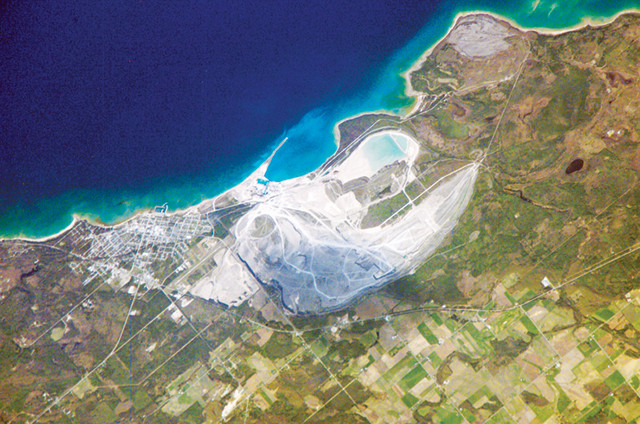
by U.S. Geological Survey Thursday, November 19, 2015
Lisa A. Corathers, a mineral commodity specialist at the U.S. Geological Survey, National Minerals Information Center, compiled the following information on lime, an indispensable mineral material used in many ways.

The world's largest limestone quarry, Calcite Quarry in Michigan, has been active since 1910. Credit: NASA Earth Observatory.
Lime is the common term for several chemicals in three major categories: quicklime, hydrated lime and refractory dead-burned dolomite. Lime is almost never found naturally. It is primarily manufactured by burning limestone in kilns, followed by hydration when necessary.
When crushed limestone is heated to temperatures between 980 and 1,320 degrees Celsius, it breaks down into either high-calcium quicklime (calcium oxide) or dolomitic quicklime (calcium-magnesium oxide); the heating process also produces carbon dioxide gas, which is vented to the atmosphere. If the temperature is raised to about 1,650 degrees Celsius, dolomitic quicklime becomes “dead-burned,” so-called because it no longer reacts with water. Hydrated (or slaked) lime is a dry powder, putty or slurry produced in a hydrator by reacting quicklime with water. In the United States, most lime is produced as quicklime (about 85 percent).
Lime can also be produced from other calcareous materials — such as aragonite, chalk, coral, marble and shell — and as a byproduct in paper mills, carbide plants and water-treatment plants.
Lime has dozens of uses. The leading uses in the United States are in metallurgical applications, particularly as fluxes in steel and iron furnaces; environmental applications, especially in desulfurizing flue gas from utility power plants and treating drinking water and wastewater; chemical and industrial applications, predominantly in paper and pulp, precipitated calcium carbonate and sugar refining; and in construction, mainly as a soil stabilizer and in the production of mortars and stuccos.
For more information on lime and other mineral resources, visit: minerals.usgs.gov/minerals/.
Lime is produced in more than 90 countries around the world. World production of lime from 2005 to 2014 averaged 314 million metric tons per year. During that time, China led the world in lime production, averaging about 61 percent of the world total. The United States (including Puerto Rico) was the second-leading producer with 6 percent.
Annually, lime “sold or used” is considered to be equivalent to production and consumption because only small amounts of lime are stockpiled.
Lime production in the United States totaled 19.5 million metric tons in 2014, worth about $2.4 billion.
Alabama, Kentucky and Missouri, which together produced more than 6 million metric tons in 2014, are the leading lime-producing states in the U.S. Only five countries — Brazil, China, India, Japan and Russia — produced more lime than these states’ combined total.
Mortars in ruins in eastern Turkey show that lime was already being used between 14,000 and 7,000 years ago. It was used 5,000 years ago in Tibet to stabilize clays in the construction of the Shersi pyramids. Chinese, Greek, Roman and other ancient civilizations used quicklime and hydrated lime for agriculture, cloth bleaching, construction and tanning.
At the turn of the 20th century, more than 80 percent of the lime consumed in the U.S. was used in construction. By 2000, more than 90 percent of lime was used in chemical and industrial applications.
Lime usually can’t be stockpiled for more than six months because it absorbs carbon dioxide and moisture, which changes it chemically — this is one of the main factors that restricts its trade internationally.
© 2008-2021. All rights reserved. Any copying, redistribution or retransmission of any of the contents of this service without the expressed written permission of the American Geosciences Institute is expressly prohibited. Click here for all copyright requests.